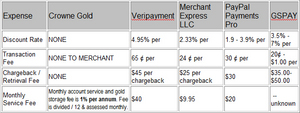Both Google Checkout and PayPal are a form of payment processor that allow merchants to accept payment through a variety of methods including debit and credit card transactions. By using either or both of these services, the merchant does not have to handle secure transactions, the services do this for the merchant.
Google Checkout processes credit card and debit card purchases for merchants that sign up for the program. PayPal processes credit, debit, eChecks, and payment from linked checking accounts. Both allow customers to create free personal accounts and store their credit card or account numbers on their Google Checkout or PayPal accounts so that their bank information is not exposed during a transaction.
For customers the key benefit of either service is that their financial account numbers are not given to the merchant or exposed during the transaction. Rather both services hold this data on secure servers and the customer only needs to checkout with their user name and password for their PayPal or Checkout account.
For merchants the handling of transactions allows them to focus on other aspects of their online businesses. There is also less liability associated with account number fraud or theft since the merchant is not handling the processing of the transactions.
Google Checkout’s key benefit over PayPal is the ability for merchants to use Google AdWords, a way for the merchant site to attract relevant Google AdSense ads and thus lower their cost of doing business with Google. PayPal’s key benefit over Checkout is that it is more widely used and offers payment options to users beyond credit or debit cards.
Security and Fraud Protection.
Both Google Checkout and PayPal use SSL level encryption security to secure transactions. This is the same level of security used by online banking websites. A locked padlock icon in the lower right hand corner of the user’s browser window indicates that the connection is secure. Google does offer 100% fraud protection with full refund if the fraudulent purchase is reported within 60 days. PayPal offers refunds on frauds if the amount is over $50 dollars.
Merchant Fees.
While neither service charges set up fees or monthly fees for merchants to use their processing services, both services do charge a transaction fee per transaction. As of September 2009 both Google and PayPal have identical fee schedules, charging a flat fee of $0.30 cents per transaction plus a percentage of each transaction ranging from 1.9% to 2.9% depending on the volume of sales a merchant does month to month. Both also charge an additional percentage point for international orders. The latest fee schedules for both services can be viewed at the links provided at the end of this article.
From a merchant perspective it makes sense to sign up for both Google and PayPal to give your customers the widest array of payment options. From a consumer perspective, PayPal is more widespread than Google Checkout, but it is free to set up an account with either service.
Since Google Checkout has matched PayPal on it’s transaction fee schedule it is likely that Google will match PayPal in other areas. Future potential for Google’s payment processing service can include expanding to availability outside the U.S. and accepting more types of payment methods.
Current Fee Schedules for Merchants:
Pay Pal Fees: https://www.paypal.com/cgi-bin/webscr?cmd=_display-fees-outside
Google Checkout Fees: http://checkout.google.com/seller/fees.html



